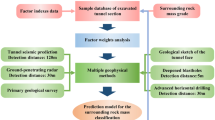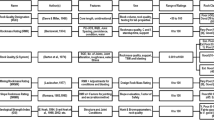Abstract
Scientific classification of rock masses surrounding tunnels has great significance for construction cost and risk in subway systems. Quantifying the surrounding rock simply, quickly, and accurately is always a challenging issue as well as an urgent requirement in construction. Surrounding rock classification considers many complex and variable factors with uncertainty and nonlinear characteristics. Using principal component analysis (PCA) and the ideal point method, a new classification model is built consisting of five key factors, uniaxial compressive strength (UCS), rock mass integrity coefficient (Kv), softening coefficient (η), joint surface coefficient (Jc), and groundwater (ω). In the model, weights of key factors are determined by PCA, then the level of the surrounding rocks is analyzed using ideal point theory. The new model is applied successfully to classify surrounding rock in the Qingdao Metro system. Results provide a reference for classifying surrounding rock quickly and guide the tunnel design and construction.



Similar content being viewed by others
References
Aydan Ö, Ulusay R, Tokashiki N (2014) A new rock mass quality rating system: rock mass quality rating (RMQR) and its application to the estimation of geomechanical characteristics of rock masses. Rock Mech Rock Eng 47(4):1255–1276
Barton N, Lien R, Lunde J (1974) Engineering classification of rock masses for the design of tunnel support. Rock Mech 6(4):189–236
Bieniawski ZT (1989) Engineering rock mass classifications: a complete manual for engineers and geologists in mining, civil and petroleum engineering. Petroleum 251(3):357–365
Deere DU, Hendron AJ, Patton FD, Cording EJ (1966) Design of surface and near-surface construction in rock. The 8th US symposium on rock mechanics (USRMS). American Rock Mechanics Association, New York
Feng YG (1996) Application of grey optimal theory model in the stability classification of adjoining rock of underground construction. Chin J Geotech Eng 18(3):62–66 (In Chinese)
Gong FQ, Li XB (2007) Application of distance discriminate analysis method to classification of engineering quality of rock masses. Chin J Rock Mech Eng 26(1):190–1994 (In Chinese)
Hamidi JK, Shahriar K, Rezai B, Rostami J (2010) Performance prediction of hard rock TBM using Rock Mass Rating (RMR) system. Tunnel Underground Space Technol Incorporating Trenchless Technol Res 25(4):333–345
Hoek E, Marinos P, Benissi M (1998) Applicability of the geological strength index (GSI) classification for very weak and sheared rock masses. The case of the Athens schist formation. Bull Eng Geol Environ 57(2):151–160
Jian W (2005) Comprehensive assessment underground water quality assessment in Huaibei city area based on multiple-goal decision making and ideal point method. Environ Sci Manag 30(4):111–112 (In Chinese)
Jolliffe IT (1986) Principal component analysis and factor analysis. Principal component analysis. Springer, New York
Li ZQ, Xue YG, Qiu DH, Xu ZH, Zhang XL, Zhou BH, Wang XT (2017) AHP-ideal point model for large underground petroleum storage site selection: an engineering application. Sustainability 9(12):2343–2355
Ma J, Ma W, Xu D, Qiu Y, Wang ZP (2014) A power restoration strategy for the distribution network based on the weighted ideal point method. Int J Electr Power Energy Syst 63(2):1030–1038
Qiu DH, Li SC, Zhang LW, Xue YG, Su MX (2010) Prediction of surrounding rock classification in advance based on TSP 203 system and GA-SVM. Chin J Rock Mech Eng 29(S1):3221–3226 (In Chinese)
Qiu DH, Xue YG, Su MX, Wang K, Tian H (2011) Study on surrounding rock stability based on the efficacy coefficient method and rough set. J Shandong Univ (Eng Sci) 41(5):92–96 (In Chinese)
Terzaghi K (1946) Rock Defects and loads on Tunnel Supports. Harvard Univ
Wang YC, Sun HY, Shang YQ, Zhu M (2010) Classification of surrounding rock based on Delphi method and ideal point method. Chin J Geotech Eng 32(4):651–656 (In Chinese)
Wang ZS, Wang LJ, Su HL, Cui ZL (2011) Optimization of coarse aggregate content based on efficacy coefficient method. J Wuhan Univ Technol (Mater Sci Ed) 26(2):330–335
Wang YC, Jing HW, Han LJ, Yu LY, Zhang Q (2014) Risk analysis on swell–shrink capacity of expansive soils with efficacy coefficient method and entropy coefficient method. Appl Clay Sci 99(9):275–281
Wang X, Ren LJ, Jiao FC, Liu WJ (2017) The ecological risk assessment and suggestions on heavy metals in river sediments of Jinan. Water Sci Technol 76(8):2177–2187
Wold S, Esbensen K, Geladi P (1987) Principal component analysis. Chemom Intell Lab Syst 2(1–3):37–52
Xu CH, Ren QW (2004) Fuzzy-synthetical evaluation on stability of surrounding rockmasses of underground engineering. Chin J Rock Mech Eng 23(11):1852–1853 (In Chinese)
Yang CH, Liu HW (1999) Artificial neural network model for the stability classification of adjoining rock of underground construction. J Sichuan Union Univ: Eng Sci Ed 3(4):66–72 (In Chinese)
Zhang W, Li XB, Gong FQ (2008) Stability classification model of mine-lane surrounding rock based on distance discriminant analysis method. J Cent S Univ Technol 15(1):117–120 (In Chinese)
Acknowledgements
This work was supported by the National Natural Science Foundation of China (grant numbers 51422904, 51379112, and 41772298) and the Shandong Provincial Natural Science Foundation (grant number ZR2013EEQ024, JQ201513, and ZR2017MEE032). The authors would like to express appreciation to the reviewers for their valuable comments and suggestions that helped improve the quality of our paper.
Author information
Authors and Affiliations
Corresponding author
Rights and permissions
About this article
Cite this article
Xue, Y., Li, Z., Qiu, D. et al. Classification model for surrounding rock based on the PCA-ideal point method: an engineering application. Bull Eng Geol Environ 78, 3627–3635 (2019). https://doi.org/10.1007/s10064-018-1368-5
Received:
Accepted:
Published:
Issue Date:
DOI: https://doi.org/10.1007/s10064-018-1368-5




